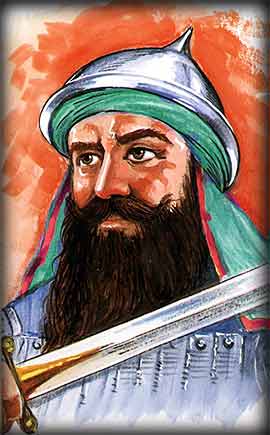
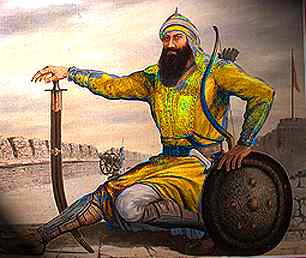
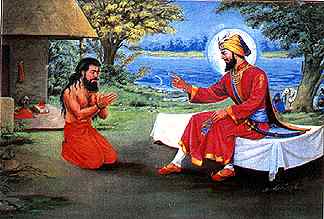
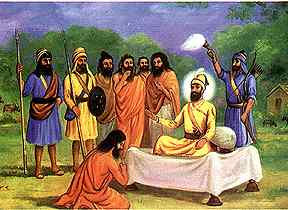
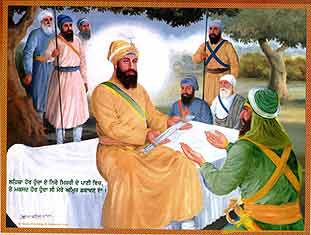
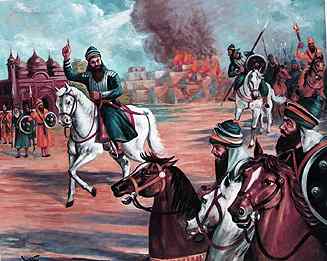
In April 1715, Banda Bahadur was carrying on operations to the north of Amritsar,
when a huge Mughal army attacked him. As his forces were being pur-sued from
three sides, he had no other al-ternative but to rush into the large haveIi;
or mansion, of Duni Chand in village Gurdas Nangal. This haveli, with its
large com-pound, was improvised into a small fortress. The imperial forces
laid siege to the village and Banda's provisions were soon ex-hausted. In
the absence of grains, men ate grass, leaves, and the bark of trees. When
even these were exhausted, they ate the flesh of horses, mules, and even the
forbid-den oxen. The siege continued for eight months. Hundreds of Sikhs had
died and the remaining were reduced to mere skeletons. They had become too
weak to wield any weapons.
The imperial army entered the fortress on December 7,1716, and took the Sikhs
as prisoners. Abdus Samad Khan, the Governor of Panjab, showed the manner
in which he meant to deal with the lives of the defeated enemy by ordering
the immedi-ate execution of over 200 prisoners, filling the ground with blood.
The remainder, in-cluding Banda and his family, were put in chains and were
sent first to Lahore, and then to Delhi.
Chained and fettered, Banda Singh was put in an iron cage, which was hooked
up on the back of a tall elephant. Others were also chained and fastened on
camels, horses, and mules. Some Sikhs were tied to-gether in pairs, chained
together by their feet, waist, and neck, and placed in bul-lock carts. 300
Sikh heads were stuck up on spears and cart loads of Sikh heads
fol-lowed behind them. Zkariya Khan's cav-alry marched in the rear.
They reached Delhi on February 25, 1 716. On the arrival of the procession
at the imperial fort, Banda bahadur, Baj Singh, Fateh Singh, and a few other
leaders were handed over to Ibrahim-ud-Din Khan, Mir Atish, to be imprisoned
at the Tripolia. The remaining Sikhs were handed over to Sarbrah Khan Kotwal
for execution.
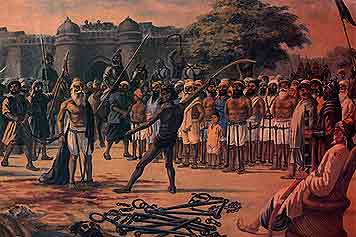
The executions on March 5, 1716. A hundred Sikhs were beheaded every day
opposite the Chabotra Kotwali, in the space now attached to the Harding Library.
Life was promised to anyone who would embrace Islam, but not even one Sikh
abandoned his faith. They even tried to outbid one another to be the first
to be sac-rificed, saying to the execu-tioner, "Me, mukta (deliverer),
kill me first."
For three months, Banda Bahadur and his leading companions were spared in
the hope of getting information about where their treasures lay. Banda's turn
came on June 9,1716. He was taken to the tomb of Bahadur Shah in Mehrauli
near Qutab Minar and was executed there. First, his three-year-old son, Ajai
Singh, was hacked to bits before his eyes and his son's quivering heart was
thrust into his mouth. Then Banda's eyes were taken out, his hands and feet
were cut off, his flesh was torn with red-hot pincers, and finally his head
was chopped off. He remained calm and serene up to the last. The remains of
his body were removed by some Sikh shopkeepers of Delhi and were cremated
near vadda-pull. The other prisoners were exe-cuted the next day.
Valour of Baj Singh
Baj Singh was a descendent of the fam-ily of the third Guru, Guru Amardas
Ji.
He came from the village of Mirpur. He was given Amrit by Guru Gobind Singh
Ji and was a celebrated, brave warrior of the Khalsa. In September 1708, when
Guru Gobind Singh Ji invested Banda Bahadur with the authority to wage war
against the religious and political tyranny in Panjab, Baj Singh was one of
the five de-voted Sikhs the Guru gave to Banda as an advisory council. The
other four Sikhs were Binod Singh, Ram Singh, Vijay Singh, and Kahn Singh.
Baj Singh's brother, Ram Singh, was also one of the right hand men of Banda
Bahadur.
After a few conquests, Banda attacked Sirhind on May 12, 710 to punish Wazir
Khan, the Governor of Sirhind, for his heinous crimes. In this battle Baj
Singh faced Suchanand, the chief secretary of the Nawab, while Banda faced
Nawab Wazir Khan. Baj Singh fought with such valour and ferocity that Suchanand
and his forces were soon vanquished in the battlefield. Baj Singh then joined
Banda Singh, and they converged around Wazir Khan. Baj Singh rushed toward
Wazir Khan, who then threw a spear at him. Baj Singh caught hold of the spear
and flung it back upon Wazir Khan. It struck the fore-head of Wazir Khan's
horse. At this point Wazir Khan discharged an arrow, which struck Baj Singh's
arm, and then rushed at him with his sword. Seeing Baj Singh under attack,
Fateh Singh struck his sword with such a force that it cut Wazir Khan from
shoulder to waist. Such valour, courage, and skillful wielding of arms by
Sikh warriors like Baj Singh won the battle of Sirhind.
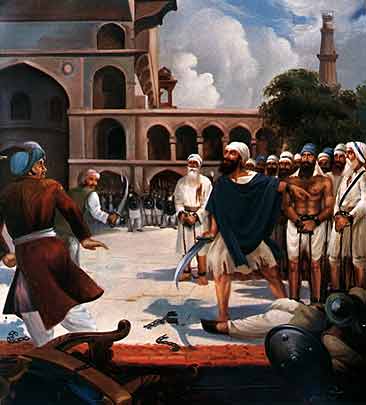
Later Baj Singh was one of the 740 Sikhs captured along with Banda Bahadur at Gurdas Nangal and brought to Delhi. While about 700 Singhs had been exe-cuted in March 1716, some of the Sikh leaders, along with Baj Singh and Fateh Singh, were kept alive to gain information about their treasure. When finally they were being executed near Qutab Minar on June 10,1 716, Emperor Farukh Siyar sarcastically asked if the famous Baj Singh, with his so-called unmatched valour, was present there. Bal Singh proudly announced his presence and demanded to be freed from his shackles if his valour was to be tested. As soon as his chains were removed, Baj Singh snatched a sword from a Mughal soldier, pounced upon the surrounding soldiers, and sent them running for their lives. He slashed the heads of seven guards before they could act. Emperor Farukh Siyar had a narrow escape. (Courtesy Dr. Santokh Singh-'The Guru's word)
